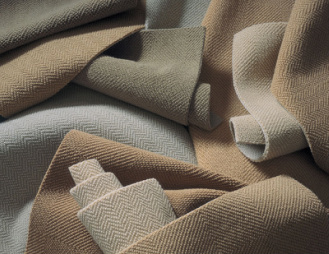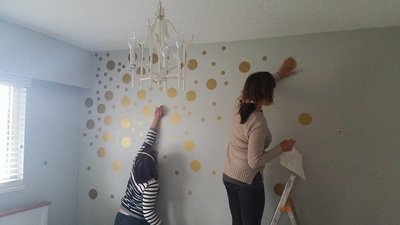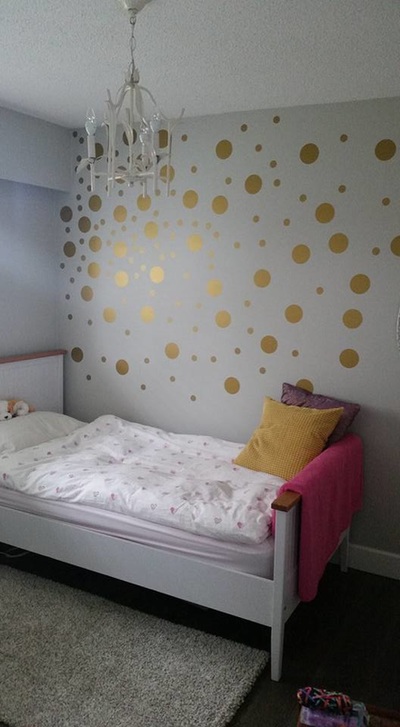|
Bringing Back Colors
After a seemingly never-ending reign of beiges, browns and greys in interior design, muted colors are finally left behind to make room for lush, unmuted colours. The trick is how to use them without overdoing it. Keeping to a single family of hues (such as blue or green) can tie together a showy range of floral, geometric and other motifs. Big-ticket, semi-permanent fixtures such as a sofa or coffee table should be kept neutral in tone, while anything that can be rolled up, scraped away or easily hauled off (such as an area rug, cushions or chairs) provide the decorative punch - this technique is the safest way to incorporate the trends of the day. (all items Homesense) It’s In the Mix The greys that have dominated decor of late definitely served a purpose: Grey provides a great “canvas” to show off more colorful art work and it is also a classy color that adds elegance to walls, floors and cabinets. Even so, trendy homeowners are wanting some oomph this season, a fact that hasn’t been lost on design brands. From MissoniHome to West Elm, colour is back. On the retail front, houseware and furniture sellers are also brightening things up. Could this finally be the dawn of a brighter new age? (Organic Bead Print Ikat Duvet – West Elm) Color Trends Paint companies in particular are making a brighter splash this year. For example, Para Paints presented new colour palettes with names such as Beach House and Island Escape and its colour of the year, shown above, is a yellow called Plaintain Chips (PF52).
1 Comment
 Wool Carpets Are Beautiful, Durable and Eco-Friendly Wool Carpets Are Beautiful, Durable and Eco-Friendly Do you have a case of the winter blues? If you are feeling sluggish, tired and are getting headaches, it might not be only the weather that’s to blame. With less ventilation than in the summer months, our indoor air quality takes a serious hit. Since so much of what we use in furnishings and building materials s sourced from all over the world, we are exposed to up to 800 different toxins in our houses. One of the most commonly found toxins are VOCs (Volatile Organic Compounds). Indoors, VOCs can be up to five times higher than outdoors, causing eye and respiratory irritation, headaches and dizziness as well as serious chronic conditions. Children, seniors and people with allergies or respiratory problems are even more susceptible to irritation and illness caused by VOCs (consult this website for additional information on VOCs and related health risks: HYPERLINK "http://www.epa.gov/iaq/voc.html" http://www.epa.gov/iaq/voc.html). If you are doing renovations during the winter, consider that new carpets, paints, millwork and new furniture can make you sick. New nylon carpets are one of the main sources of off-gassing and the “new carpet” smell is actually the odor of toxins off-gassing. Wool Versus Nylon While nylon carpet is known for its durability and affordability, it’s not exactly a green choice. It takes nylon carpet over 50 years to degrade and over 250 million pounds of it end up in Canada’s landfill every year (efforts are being made to recycle nylon carpet - Aspera Recycling has 9 collection sites across Canada). It’s just as bad for your indoor air quality: Nylon carpets can emit VOCs for over five years and the adhesive used to affix the carpet to the floor typically contains benzene* and toluene**, some of the most harmful VOCs around. Even though the off-gassing decreases significantly several months after installation, it is recommendable to use fans during installation and for several weeks afterward. Another recommendation is to ask the installer to vacuum the new carpet with a HEPA filter vac and clean with a hot water extraction, which can remove a good portion of the VOCs. Dangers of Benzene http://www.epa.gov/ttn/atw/hlthef/benzene.html Dangers of Toluene http://www.epa.gov/ttn/atw/hlthef/toluene.html Five green reasons to choose wool carpet: 1. Wool is sustainable and biodegradable: Grown on sheep, which graze freely, wool is 100% natural and fully sustainable. As shearing is necessary part of animal husbandry this means that every year there is a fresh supply of wool available for the carpet manufacturing industry. Wool fiber is biodegradable in soil and will produce nitrogen, sulphur, carbon dioxide and water, which are all plant nutrients. 2. Wool improves indoor air quality: Wool has a complex chemical structure that helps to create a balanced atmosphere in the home. It breathes and absorbs humidity in the air, releasing it when the atmosphere becomes dry. In addition, it absorbs airborne toxins in indoor air: the minute scales on the surface will hold fine dust until vacuumed which helps to reduce floating particulate in the atmosphere. Wool does not give off harmful emissions or promote the growth of bacteria and wool is not a food source for dust mites. Wool carpet comes off the sheep’s back and can be manufactured without any dyes or synthetic chemicals. This makes it hypoallergenic (for those not allergic to wool) and great for parents who are concerned about exposing their kids to chemicals. 3. Wool is naturally stain and fire resistant: Wool carpet’s ability to resist stains goes a step beyond other fibers. When properly treated, all fibers have a degree of stain resistance. Wool fiber naturally does a good job of repelling stains (treated nylon and Smartstrand carpets probably resist liquid stains better). In addition, wool does a good job of hiding soil stains and repelling oil stains, whereas the other fibers tend to attract oils. Wool is also naturally fire resistant, has a slow ignition rate and tests show that it is self-extinguishing within seconds. It meets many safety regulations without additional treatments. 4. Wool insulates: One way wool carpet might justify its cost is by reducing your heating and air conditioning bills. Wool is a great insulator, so it will limit the transfer of heat (or cool air) from the outside world into your home. In addition, wool carpet can significantly improve the acoustic performance of rooms as it acts as a sound absorber and also dampens any impact noise in a room. 5. Wool is durable: if properly cared for, wool carpet can last up to 60 years. Also, wool carpet doesn’t matte down easily. Wool carpet retains its pile shape and height and recovers quickly from furniture compression. Disadvantage of wool: Wool carpets fade in the sun and absorb water. You’ll want to avoid putting wool carpet in any room that gets constant sunlight. Exposing the carpet to a little sunlight here or there isn’t going to be a problem, just make sure to limit it. Another disadvantage is that wool carpets hold water, so avoid wool in any rooms with a moisture problem. The beginning of a new year is a good time to opt for a health-conscious, “green” renovation because like it or not – for the next few months most of our time will be spent inside buildings, making high Indoor Air Quality especially important. The first months of the year are also a good time to renovate because it’s a slow time for trades and there is often little wait time to book quality installers. Suppliers tend to have sales on. Call MOVIKE DESIGN for a consultation on a no-VOC paint scheme to freshen up your walls or for advice on “green” flooring options.  Does your furnace keep you awake at night because it’s too noisy or makes worrisome, asthmatic sounds? If the answer is yes, it’s high time for your annual furnace service. Over the past few years, I have been trying out different companies (using Groupons and Wagjag “Service Special” deals) and haven't found there to be a big difference between them Invariably, the servicemen seem to find something in need of immediate repair, costing around $300 (the price also hardly changes). To be honest, having my furnace serviced feels a bit like taking my car to the garage – I really have no clue how the thing works and the repairmen are fast to clue into my Achilles heel. I usually go along with their recommendation, mainly because I don’t want to wake up one morning with iceflowers blooming on my windows and no time to arrange for a repair. Some companies offer a “care” plan and for an annual fee, they give a discount on repairs. This helps give peace of mind and is recommendable if the company is proven to do reliable, quality work in the past. While still looking for the perfect partner in all things heating, I have learnt a couple of things: #1: It is highly recommended to change the furnace filter every month during heating season. I have a washable one - it is a bit pricier but comes with a lifetime warranty. I hose it down with warm water in the tub (I put a towel underneath so I don’t scratch the tub) and then take it out to blow dry it. BTW: floor registers actually shouldn’t have filters in them as it puts extra strain on the furnace, so I removed mine. #2: In regards to whether it’s better to keep the temperature constant or to turn it down during the night, opinions differ. Apparently, turning it down by one degree Fahrenheit over an eight-hour period saves 1% of heating costs (turning it down 10 degrees would then save 10%). However, reheating the house in the morning eats up the savings gained during the night, since the walls and everything else take a while to be reheated. I have tried it both ways and settled on turning the heat down to 63 degrees Fahrenheit during the night or 65 degrees when I am away for several hours. The house still heats up fairly quickly in the morning and my heating bill is quite a bit lower than if I leave it at a constant temperature. |
AuthorInterior Designer Viviane Schmidt Mumm has spent the last 23 years in Vancouver, BC and the Lower Mainland. Archives
April 2014
Categories
All
|


 RSS Feed
RSS Feed 